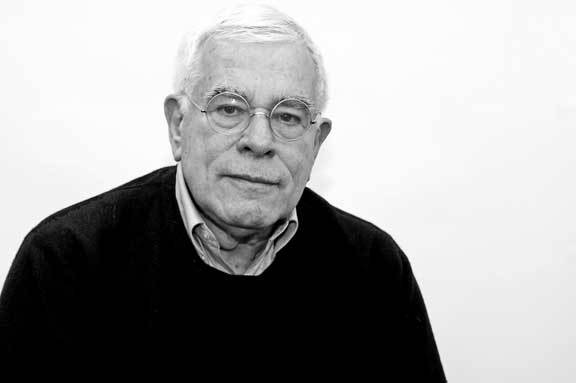Peter Eisenman (born August 11, 1932) is an American architect. Eisenman’s professional work is often referred to as formalist, deconstructive, late avant-garde, late or high modernist, etc. A certain fragmenting of forms visible in some of Eisenman’s projects has been identified as characteristic of an eclectic group of architects that were (self-)labeled as deconstructivists, and who were featured in an exhibition by the same name at the Museum of Modern Art. The heading also refers to the storied relationship and collaborations between Peter Eisenman and post-structuralist thinker Jacques Derrida.
Peter Eisenman (born August 11, 1932) is an American architect. Eisenman’s professional work is often referred to as formalist, deconstructive, late avant-garde, late or high modernist, etc. A certain fragmenting of forms visible in some of Eisenman’s projects has been identified as characteristic of an eclectic group of architects that were (self-)labeled as deconstructivists, and who were featured in an exhibition by the same name at the Museum of Modern Art. The heading also refers to the storied relationship and collaborations between Peter Eisenman and post-structuralist thinker Jacques Derrida.
Eisenman was born in Newark As a child he attended Columbia High School located in Maplewood, New Jersey. He discovered architecture as an undergraduate at Cornell University and gave up his position on the swimming team in order to immerse himself in the architecture program there. Eisenman received a Bachelor of Architecture Degree from Cornell, a Master of Architecture Degree from Columbia University’s Graduate School of Architecture, Planning and Preservation, and M.A. and Ph.D. degrees from the University of Cambridge. He received an honorary degree from Syracuse University School of Architecture in 2007.Eisenman currently teaches theory seminars and advanced design studios at the Yale School of Architecture. He is Professor Emeritus at the Cooper Union School of Architecture. Eisenman formerly taught at Cambridge University, Harvard University, the University of Pennsylvania, Princeton University, and the Ohio State University.
Eisenman first rose to prominence as a member of the New York Five , five architects (Eisenman, Charles Gwathmey, John Hejduk, Richard Meier, and Michael Graves) some of whose work was presented at a CASE Studies conference in 1967. Eisenman received a number of grants from the Graham Foundation for work done in this period. These architects’ work at the time was often considered a reworking of the ideas of Le Corbusier. Subsequently, the five architects each developed unique styles and ideologies, with Eisenman becoming more affiliated with the Deconstructivist movement.
Eisenman’s focus on “liberating” architectural form was notable from an academic and theoretical standpoint but resulted in structures that were both badly built and hostile to users. The Wexner Center, hotly anticipated as the first major public deconstructivist building, has required extensive and expensive retrofitting because of elementary design flaws (such as incompetent material specifications, and fine art exhibition space exposed to direct sunlight). It was frequently repeated that the Wexner’s colliding planes tended to make its users disoriented to the point of physical nausea; in 1997 researcher Michael Pollan tracked the source of this rumor back to Eisenman himself. In the words of Andrew Ballantyne, “By some scale of values he was actually enhancing the reputation of his building by letting it be known that it was hostile to humanity.”
Eisenman is featured in wide print and many films, including the 30 minute 2008 film Peter Eisenman: University of Phoenix Stadium for the Arizona Cardinals where he provides a tour of his recent construction.In 2001, Eisenman won the National Design Award for Architecture from the Cooper-Hewitt National Design Museum.
Buildings and works
USGS satellite image of the Greater Columbus Convention Center.
Falk House (House II Eisenman), Hardwick, Vermont, 1969
House VI (Frank residence), Cornwall, Connecticut, Design: 1972.
Wexner Center for the Arts, Ohio State University, Columbus, Ohio, 1989
Nunotani building, Edogawa Tokyo Japan, 1991
Greater Columbus Convention Center, Columbus, Ohio, 1993
Aronoff Center for Design and Art, University of Cincinnati, Cincinnati, Ohio, 1996
City of Culture of Galicia, Santiago de Compostela, Galicia, Spain, 1999
Il giardino dei passi perduti, Castelvecchio Museum, Verona, 2004
Memorial to the Murdered Jews of Europe, Berlin, 2005
University of Phoenix Stadium, Glendale, Arizona, 2006







